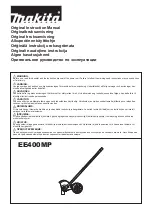
22
/
99
4.6 User Interface
Figure 4-5 User Interface
User interface as shown in Figure 4-5 and the detailed description see the following.
①
Trigger status identification: TRIGED (has been triggered), AUTO, READY, STOP, and ROLL.
②
Timebase scale: Indicates the amount of time represented by one grid, which can be adjusted by the
horizontal scale knob.
③
Sampling rate/Storage depth: Indicates sampling rate and storage depth of the current scale.
④
Horizontal displacement: Display the horizontal displacement value of waveform, which can adjusted
by turning POSITION knob on the horizontal control. Press the knob returns the displacement back
to 0.
⑤
Trigger status: Displays trigger source, type, slope, coupling, mode, level, etc.
a. Trigger source: There are CH1~CH2, mains electricity and EXT states. CH1~CH2 will display
different trigger state colors based on channel colors. For example,
presents trigger source
is CH1.
b. Trigger type: The types are edge, pulse width, video, slope, and advanced trigger. For example,
presents edge trigger.
c.
Trigger slope: The types are rising, falling, and random. For example,
presents rising edge
trigger.
d. Trigger coupling: The types are DC, AC, HF rejection, LF rejection and noise. For example,
indicates DC coupling.
7 8
6
5
4
2
3
10
9
11
⑩
1
1
















































